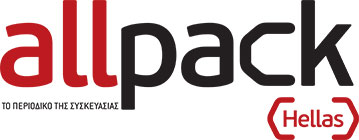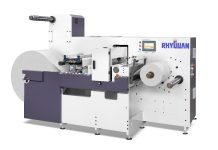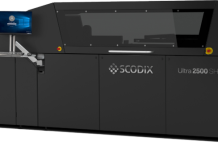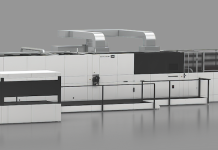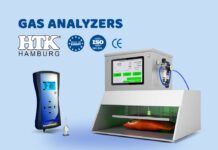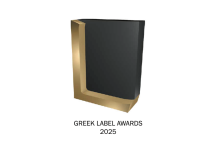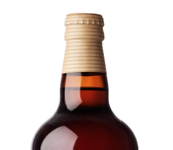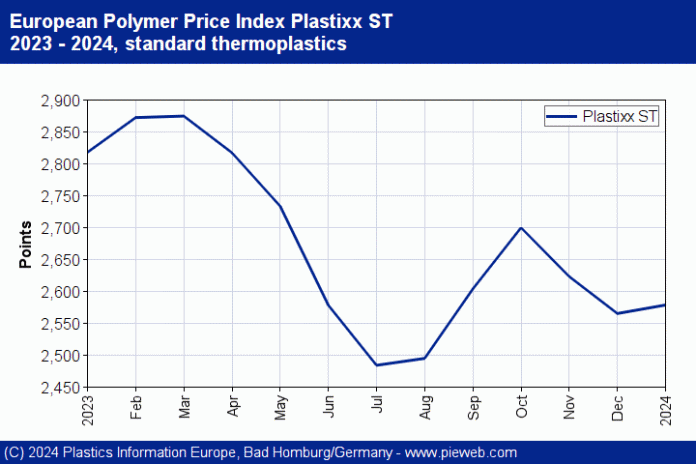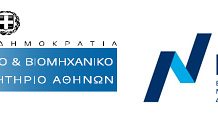Most grades see no major price movement / Only PET quotes rise unexpectedly on fewer imports due to Red Sea conflict / In part substantial hikes expected in February
PE: Many January price agreements in Europe followed the C2 rollover. Even in the second half of the month there was seldom any increase in the volume of orders. Many producers closed their order books early hoping for increases in February. Most European production plants are still operating with reduced output. Because of the unrest in the Red Sea, imports were delayed while also becoming significantly more expensive. Reports of forces majeures added to the trouble. Even without the European C2 contract being fixed, calls for triple-digit hikes are already circulating on the market. This will provoke more intense negotiations because a revival in demand is still not on the horizon, and converters are likely to resist producers’ calls for increases. No serious supply bottlenecks are to be expected. For individual grades, delivery times could become a little longer. Converters will presumably operate cautiously for the time being, or stop ordering altogether and instead work from their stocks. Those who have primarily opted for favourably priced imports will now, in view of the chaos in the supply chains, likely try to obtain more of their material from European production. This might have a detrimental effect on availability for the overall market.
PP: Following the rollover for C3, the prices for polypropylene also only changed slightly in January 2024. Attempts by suppliers to impose surcharges generally failed due to weak demand. The low demand for reinforced compounds also led to slight discounts. The situation is, however, now changing – this is because several producers imposed order freezes in January in order to influence the market structure in their favour. The turbulence on the Red Sea plays into their hands, as imports likely will be delayed and become more expensive due to the longer transport routes. Several providers have renewed their attempt to increase prices in February, and have already announced markups in the three-digit range. Even if these demands cannot be enforced in full, the foreseeable price increases are certainly expected to exceed the price increase of C3 for February (a plus of EUR 15/t).
PVC: The downward trend in PVC prices came to an end in January. Following the rollover for feedstock ethylene, negotiations for the base product frequently resulted in a sideways movement too. The sole exception was E-PVC pastes. A number of customers felt that there was still a need for adjustment after the annual talks, and prices had to be brought down again. The curtailed output of European plants was sufficient to meet demand. At the same time, imports from the US remained unattractive for many buyers. Since imports from East Asia were now also unable to reach Europe via their usual route due to the situation in the Red Sea, at least some local producers were able to welcome former customers who came knocking. Demand also remained subdued in January. While converters’ orders picked up again slightly at the start of the year, this was due to the usual seasonal build-up of stocks of finished and semi-finished products and not due to a real upswing in incoming orders. Looking ahead, a rollover is likely for the base material once again. Initial price increases for additives – frequently attributed to delayed and more expensive deliveries from Asia – may lead to a slight firming of compound prices in February.
Styrenics: On the surface, styrenics prices remained calm at the start of 2024: following the marginal decline in the styrene reference (down EUR 5/t), prices remained largely unchanged. PS saw a couple of small upward or downward adjustments, while EPS and ABS quotations ultimately rolled over or – due to weak demand – came with slight discounts. All in all, there were only minor changes at most. Despite this, things began to boil under the surface. Styrene spot prices climbed steeply over the course of the month, as the output of European plants was significantly reduced by maintenance and unforeseen production problems, and also because the feedstock benzene became more expensive. The result was a strong increase in the styrene reference for February (up EUR 190/t), which is bound to drive SM up into the triple-digit range. The turmoil in the Red Sea is also expected to have an impact, at least on ABS: longer shipping routes around the Cape of Good Hope are set to delay imports from Asia and also increase shipping costs – market players have reported premiums of up to EUR 250/t. European producers likely will be pleased by this, because higher import prices are strengthening their position against Asian competitors.
PET: The European PET market went through two distinct phases in January 2024. While slight reductions were still possible at the start of the month, the situation changed rapidly with the escalation of the conflict off the coast of Yemen near the Horn of Africa. As more ships were diverted, imports were delayed and became more expensive at all levels of the value chain. Basic prices in Asia also rose significantly as a result of China’s economic stimulus programme. Many converters were forced to switch to European material, which was still only available in reduced quantities. Bottlenecks then also emerged in the direct feedstock PTA, prompting hikes up to triple digits at the end of the month. Average price rises of EUR 60 to 80/t were recorded over the course of the month. February is likely to see further, at least moderate, increases regardless of what happens with paraxylene. Imports are set to remain relatively expensive. The increased logistics costs are, however, already largely priced in. How things develop in China will only become clear in the second half of the month after the Spring Festival, especially considering the anti-dumping investigations into Chinese PET imports that were recently launched by South Korea, Mexico, and Europe. In Europe, at least a slight upturn in production can be expected. At the same time, the outlook for demand remains uncertain during the pre-season period.
For more than 35 years, PIE has been an invaluable source of information for European plastics industry decision makers – a quick, yet in-depth look at the development of plastics markets and polymer prices. Available online 24/7 and as a printed newsletter twice a month. To read the entire report, go to www.pieweb.com and sign up for a 48-hour free trial!
